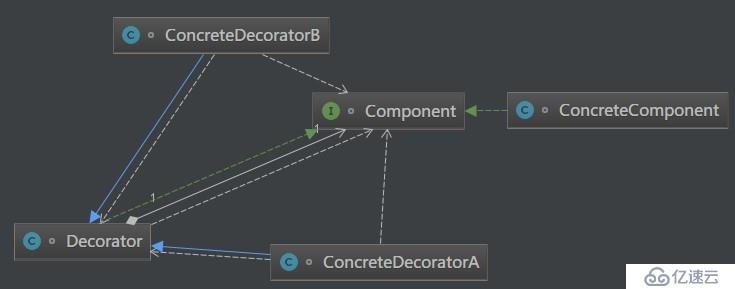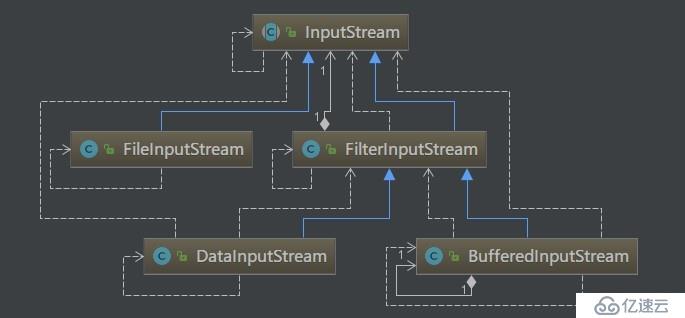Java描述设计模式(09):装饰模式
导读:本文共3870字符,通常情况下阅读需要13分钟。同时您也可以点击右侧朗读,来听本文内容。按键盘←(左) →(右) 方向键可以翻页。
摘要: 本文源码:GitHub·点这里 || GitEE·点这里一、生活场景1、场景描述孙悟空有七十二般变化,他的每一种变化都给他带来一种附加的本领。他变成鱼儿时,就可以到水里游泳;他变成鸟儿时,就可以在天上飞行。2、场景图解3、代码实现public class C01_InScene { public static void main(St... ...
目录
(为您整理了一些要点),点击可以直达。本文源码:GitHub·点这里 || GitEE·点这里
一、生活场景
1、场景描述
孙悟空有七十二般变化,他的每一种变化都给他带来一种附加的本领。他变成鱼儿时,就可以到水里游泳;他变成鸟儿时,就可以在天上飞行。
2、场景图解

3、代码实现
public class C01_InScene { public static void main(String[] args) { TheGreatestSage greatestSage = new Monkey(); TheGreatestSage fish = new Fish(greatestSage); fish.shapeDesc(); // 这里虽然是鱼形态,但是本体是悟空,所以可以直接变化 TheGreatestSage bird = new Bird(fish); bird.shapeDesc(); }}// 顶级接口interface TheGreatestSage { // 定义一个描述形态的方法 void shapeDesc ();}// 悟空本尊class Monkey implements TheGreatestSage{ @Override public void shapeDesc() { System.out.println("Monkey.move()"); }}// 包装一层变化的描述class Change implements TheGreatestSage { private TheGreatestSage greatestSage; Change(TheGreatestSage greatestSage){ this.greatestSage = greatestSage; } @Override public void shapeDesc() { greatestSage.shapeDesc(); }}// 具体的变化形态class Fish extends Change{ public Fish(TheGreatestSage greatestSage) { super(greatestSage); } public void shapeDesc(){ System.out.println("鱼在水中游..."); }}class Bird extends Change{ public Bird(TheGreatestSage greatestSage) { super(greatestSage); } public void shapeDesc(){ System.out.println("鸟在空中飞..."); }}二、装饰模式
1、基础概念
装饰模式又名包装(Wrapper)模式。装饰模式以对客户端透明的方式扩展对象的功能,是继承关系的一个替代方案。
装饰模式以对客户透明的方式动态地给一个对象附加上更多的责任。换言之,客户端并不会觉得对象在装饰前和装饰后有什么不同。装饰模式可以在不使用创造更多子类的情况下,将对象的功能加以扩展。
2、核心角色
3、模式图解

4、源代码实现
// 抽象构件角色interface Component { void sampleOperation();}// 具体构件角色class ConcreteComponent implements Component{ @Override public void sampleOperation() { System.out.println("业务相关代码"); }}//装饰角色class Decorator implements Component{ private Component component; public Decorator(Component component){ this.component = component; } @Override public void sampleOperation() { //委派给构件进行处理 component.sampleOperation(); }}// 具体装饰角色class ConcreteDecoratorA extends Decorator{ public ConcreteDecoratorA(Component component) { super(component); } @Override public void sampleOperation() { super.sampleOperation(); System.out.println("A.处理相关业务的代码"); }}class ConcreteDecoratorB extends Decorator{ public ConcreteDecoratorB(Component component) { super(component); } @Override public void sampleOperation() { super.sampleOperation(); System.out.println("B.处理相关业务方法"); }}5、该模式简化
如果只有一个ConcreteComponent类,那么可以考虑去掉抽象的Component类(接口),把Decorator作为一个ConcreteComponent子类。
如果只有一个ConcreteDecorator类,那么就没有必要建立一个单独的Decorator类,而可以把Decorator和ConcreteDecorator的责任合并成一个类。
6、半透明说明
1)、纯粹的装饰模式很难找到。装饰模式的用意是在不改变接口的前提下,增强类的功能。
2)、在增强功能的时候,往往需要建立新的公开的方法。
3)、这就导致了大多数的装饰模式的实现都是“半透明”的,而不是完全透明的。换言之,允许装饰模式改变接口,增加新的方法。这意味着客户端可以声明ConcreteDecorator类型的变量,从而可以调用ConcreteDecorator类中才有的方法。
4)、半透明的装饰模式是介于装饰模式和适配器模式之间的。适配器模式的用意是改变类的接口,也可以通过改写一个或几个方法,或增加新的方法来增强类的功能。
5)、大多数的装饰模式实际上是半透明的装饰模式,这样的装饰模式也称做半装饰、半适配器模式。
三、实际应用
1、JDK中IO流
1)、基本描述
装饰模式在Java语言中的最经典的应用就是Java I/O类库的设计。很少单一的创建流对象,通过创建多个叠合对象来提供所期望的IO流功能,因此装饰模式是Java I/O类库的基本模式。
2)、IO流图解描述

由InputStream扮演。这是一个抽象类,为各种子类型提供统一的接口。
由FileInputStream、StringBufferInputStream等类扮演。它们实现了抽象构件角色所规定的接口。
由FilterInputStream扮演。它实现了InputStream所规定的接口。
由几个类扮演,分别是BufferedInputStream、DataInputStream以及两个不常用到的类LineNumberInputStream、PushbackInputStream。
四、优缺点总结
1、模式的优点
(1)装饰模式与继承关系的目的都是要扩展对象的功能,但是装饰模式可以提供比继承更多的灵活性。装饰模式允许系统动态决定“贴上”一个需要的“装饰”,或者除掉一个不需要的“装饰”。继承关系则不同,继承关系是静态的,它在系统运行前就决定了。
(2)通过使用不同的具体装饰类以及这些装饰类的排列组合,工程师可以创造出很多不同行为的组合。
2、模式的优点
由于使用装饰模式,可以比使用继承关系需要较少数目的类。使用较少的类,当然使设计比较易于进行。但是,在另一方面,使用装饰模式会产生比使用继承关系更多的对象。
五、源代码地址
GitHub·地址https://github.com/cicadasmile/model-arithmetic-parentGitEE·地址https://gitee.com/cicadasmile/model-arithmetic-parent
</div> <div class="zixun-tj-product adv-bottom"></div> </div> </div> <div class="prve-next-news">Java描述设计模式(09):装饰模式的详细内容,希望对您有所帮助,信息来源于网络。